The anatomy and physiology of voice include not only the larynx but also all body systems. The larynx consists of a skeleton, mucosa, intrinsic muscles, and extrinsic muscles. The vocal folds form the oscillator of the vocal tract, the subglottic vocal tract acts as a power source, and the supraglottic vocal tract functions as a resonator. Complex interactions are responsible for voice production.
Anatomy
The anatomy of the voice is not limited to the region between the suprasternal notch (top of the breast bone) and the hyoid bone. Practically all body systems affect the voice. The larynx receives the greatest attention because it is the most sensitive and expressive component of the vocal mechanism, but anatomic interactions throughout the patient’s body must be considered in treating the professional voice user. It is helpful to think of the larynx as composed of four anatomic units: skeleton, mucosa, intrinsic muscles, and extrinsic muscles. The glottis is the space between the vocal folds . The portions of the larynx above the vocal folds are referred to as the supraglottis. The area below the vocal folds is referred to as the subglottis. The vocal tract includes those portions of the aerodigestive tract involved in vocal production.
Larynx: skeleton
The most important parts of the laryngeal skeleton are the thyroid cartilage, cricoid cartilage, and the two arytenoid cartilages ( Fig. 1 ). Intrinsic muscles of the larynx are connected to these cartilages. One of the intrinsic muscles, the thyroarytenoid, extends on each side from the arytenoid cartilage to the inside of the thyroid cartilage just below and behind the thyroid prominence. The medial belly of the thyroarytenoid is also known as the vocalis muscle, and it forms the body of the vocal fold. The laryngeal cartilages are connected by soft attachments that allow changes in their relative angles and distances, thereby permitting alterations in the shape and tension of the tissues extended between them. The arytenoids are capable of complex motion. It used to be said that the arytenoids rock, glide, and rotate. More accurately, with adduction of the vocal folds the cartilages are brought together in the midline and revolve over the cricoid, moving inferiorly and anteriorly. It seems that people use different strategies for approximating the arytenoids and that such strategies may influence a person’s susceptibility to laryngeal trauma that can cause vocal process ulcers and laryngeal granulomas.
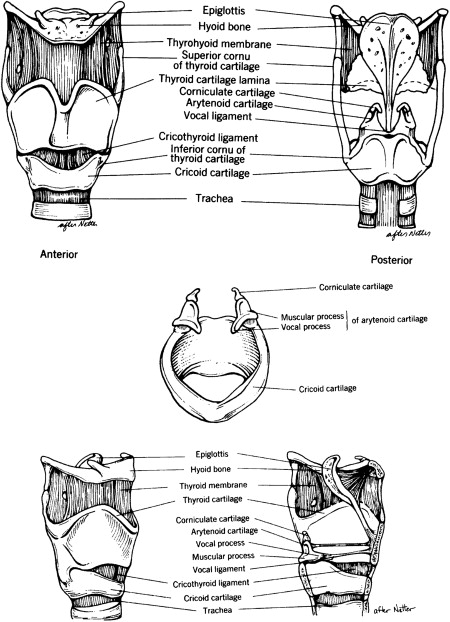
Larynx: mucosa
The vibratory margin of the vocal fold is much more complicated than simply mucosa applied to muscle or ligament. It consists of five layers ( Fig. 2 ) . The thin, lubricated epithelium covering the vocal folds forms the area of contact between the vibrating vocal folds and acts somewhat like a capsule, helping to maintain vocal fold shape. The epithelium lining most of the vocal tract is pseudo-stratified, ciliated, columnar epithelium, typical respiratory epithelium involved in handling mucous secretions. The vibratory margin of the vocal fold is covered with stratified squamous epithelium, better suited to withstand the trauma of vocal fold contact. The superficial layer of the lamina propria, also known as Reinke’s space, is composed of loose fibrous components and matrix. It contains few fibroblasts. The intermediate layer of lamina propria consists primarily of elastic fibers and does contain fibroblasts. The deep layer of the lamina propria is composed primarily of collagenous fibers and is rich in fibroblasts. The thyroarytenoid or vocalis muscle makes up the body of the vocal fold and is one of the intrinsic laryngeal muscles. The intermediate and deep layers of the lamina propria constitute the vocal ligament and lie immediately below the Reinke’s space.
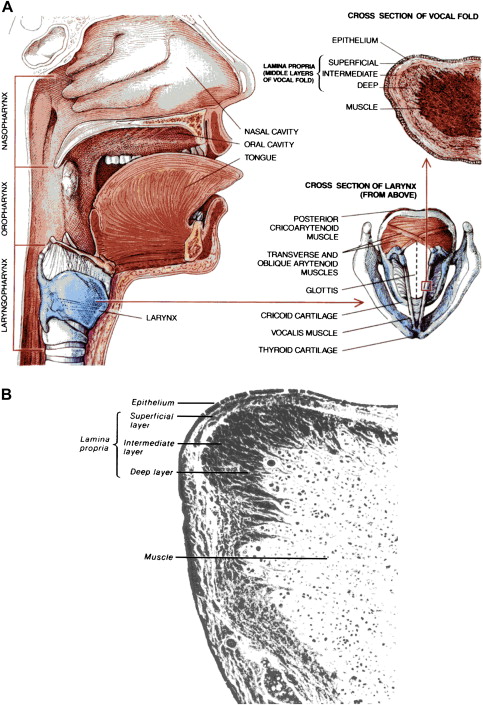
Although variations along the length of the membranous vocal fold are important in only a few situations, the surgeon, in particular, should be aware that they exist. Particularly striking variations occur at the anterior and posterior portion of the membranous vocal fold. Anteriorly, the intermediate layer of the lamina propria becomes thick, forming an oval mass called the anterior macula flava. This structure is composed of stroma, fibroblasts, and elastic fibers. Anteriorly, it inserts into the anterior commissure tendon, a mass of collagenous fibers that is connected to the thyroid cartilage anteriorly, the anterior macula flava posteriorly, and the deep layer of the lamina propria laterally. As Hirano has pointed out, this arrangement allows the stiffness to change gradually from the pliable membranous vocal fold to the stiffness of the thyroid cartilage .
A similar gradual change in stiffness occurs posteriorly where the intermediate layer of the lamina propria also thickens to form the posterior macula flava, another oval mass. It is structurally similar to the anterior macula flava. The posterior macula flava attaches to the vocal process of the arytenoid cartilage through a transitional structure that consists of chondrocytes, fibroblasts, and intermediate cells . The stiffness thus progresses from the membranous vocal fold to the slightly stiffer macula flava, to the stiffer transitional structure, to the elastic cartilage of the vocal process, to the hyaline cartilage of the arytenoid body. It is believed that this gradual change in stiffness serves as a cushion that may protect the ends of the vocal folds from mechanical damage caused by contact or vibrations . It may also act as a controlled damper that smoothes mechanical changes in vocal fold adjustment. This arrangement seems particularly well suited to vibration, as are other aspects of the vocal fold architecture. For example, blood vessels in the vibratory margin come from posterior and anterior origins and run parallel to the vibratory margin, with few vessels entering the mucosa perpendicularly or from underlying muscle. The vibratory margin contains no glands, whose presence would likely interfere with the smoothness of vibratory waves. Even the elastic and collagenous fibers of the lamina propria run approximately parallel to the vibratory margin. The more one studies the vocal fold, the more one appreciates the beauty of its engineering.
Functionally, the five layers have different mechanical properties and may be thought of as somewhat like ball bearings of different sizes that allow the smooth shearing action necessary for proper vocal fold vibration. The posterior two fifths (approximately) of the vocal folds are cartilaginous, and the anterior three fifths are membranous (from the vocal process forward) in adults. Under normal circumstances, most of the vibratory function critical to sound quality occurs in the membranous portion.
Mechanically, the vocal fold structures act more like three layers consisting of the cover (epithelium and Reinke’s space), transition (intermediate and deep layers of the lamina propria), and the body (the vocalis muscles). Understanding this anatomy is important because different pathologic entities occur in different layers and require different approaches to treatment. For example, fibroblasts are responsible for scar formation. Lesions that occur superficially in the vocal folds (such as nodules, cysts, and most polyps) should therefore permit treatment without disturbance of the intermediate and deep layers, fibroblast proliferation, or scar formation.
In addition to the five layers discussed above, recent research has shown that there is a complex basement membrane connecting the epithelium to the superficial layer of the lamina propria . The basement membrane is a multilayered, chemically complex structure. It gives rise to Type VII collagen loops that surround Type III collagen fibers in the superficial layer of the lamina propria. Knowledge of the basement membrane has already been important in changing surgical technique. Additional research is likely to show its great importance in other matters, such as the ability to heal following trauma, possibly the development of certain kinds of vocal fold pathology, and probably in histopathologic differential diagnosis.
The vocal folds may be thought of as the oscillators of the vocal mechanism . Above the true vocal folds are tissues known as false vocal folds. Unlike the true vocal folds, they do not make contact during normal speaking or singing. They may produce voice during certain abnormal circumstances, however. This phenomenon is called “dysphonia plica ventricularis.” Until recently, the importance of the false vocal folds during normal phonation was not appreciated. In general, they are considered to be used primarily for forceful laryngeal closure and they may be used excessively during pathologic conditions. Contrary to popular practice, however, surgeons should recognize that they cannot simply be removed without phonatory effects. The physics of airflow through the larynx are complex, involving vortex shedding and sophisticated turbulence patterns that are essential to phonation. The false vocal folds provide a downstream resistance that is important in this process, and they probably play a role in vocal tract resonance also.
Larynx: the intrinsic muscles
Intrinsic muscles are responsible for abduction, adduction, and tension of the vocal folds ( Figs. 3 and 4 ). All but one of the muscles on each side of the larynx are innervated by one of the two recurrent laryngeal nerves. Because this nerve runs a long course from the neck down into the chest and back up to the larynx (hence the name “recurrent”), it is easily injured by trauma, neck surgery, and chest surgery. Such injuries may result in abductor and adductor paralysis of the vocal fold. The remaining muscle, the cricothyroid muscle, is innervated by the superior laryngeal nerve on each side, which is especially susceptible to viral and traumatic injury. The recurrent and superior laryngeal nerves are branches of the 10th cranial nerve, or vagus nerve. The superior laryngeal nerve branches off the vagus high in the neck at the inferior end of the nodose ganglion. It divides into an internal and external branch. The external branch supplies the cricothyroid muscle. An extension of this nerve may also supply motor and sensory innervation to the vocal fold. The internal branch is primarily responsible for sensation in the mucosa above the level of the vocal fold, but it may also be responsible for some motor innervations of laryngeal muscles. The recurrent laryngeal nerves branch off the vagus in the chest. On the left, the nerve usually loops around the aortic arch. On the right, it usually loops around the brachiocephalic artery. This anatomic relationship is usually, but not always, present, and nonrecurrent recurrent nerves have been reported particularly on the right side, where they are more likely to be injured during neck surgery. There are interconnections between the superior and recurrent laryngeal nerves, particularly in the region of the interarytenoid muscle.
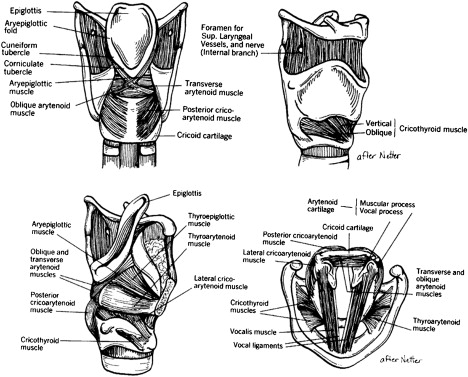
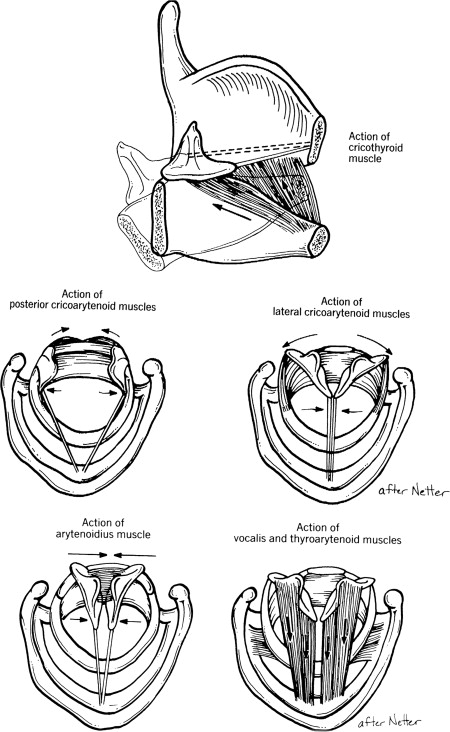
For some purposes, including electromyography, voice therapy, and surgery, it is important to understand the function of individual laryngeal muscles in greater detail. The muscles of primary functional importance are those innervated by the recurrent laryngeal nerve (thyroarytenoid, posterior cricoarytenoid, lateral cricoarytenoid, and interarytenoid or arytenoideus) and the superior laryngeal nerve (cricothyroid) (see Figs. 3 and 4 ; Fig. 5 ).
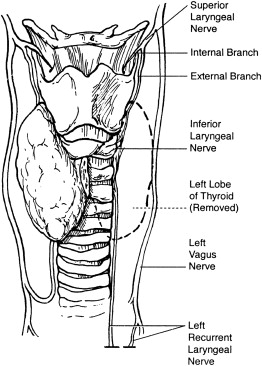
The thyroarytenoid muscle adducts, lowers, shortens, and thickens the vocal fold, rounding the vocal fold edge. The cover and transition are effectively made more slack, whereas the body is stiffened. Adduction from vocalis contraction is active, particularly in the membranous segment of the vocal folds. It tends to lower vocal pitch. The thyroarytenoid originates anteriorly from the posterior (interior) surface of the thyroid cartilage and inserts into the lateral base of the arytenoid cartilage from the vocal process to the muscular process. More specifically, the superior bundles of the muscle insert into the lateral and inferior aspects of the vocal process and run primarily in a horizontal direction. The anteroinferior bundles insert into the anterolateral aspect of the arytenoid cartilage from its tip to an area lateral to the vocal process. The most medial fibers run parallel to the vocal ligament. There are also cranial fibers that extend into the aryepiglottic fold. Anteriorly, the vertical organization of the muscle results in a twisted configuration of muscle fibers when the vocal fold is adducted. The thyroarytenoid muscle is divided into two compartments. The medial compartment is also known as the vocalis muscle. It contains a high percentage of slow twitch muscle fibers. The lateral compartment has predominantly fast twitch muscle fibers. One may infer that the medial compartment (vocalis) is specialized for phonation, whereas the lateral compartment (muscularis) is specialized for vocal fold adduction, but these suppositions are unproven.
The lateral cricoarytenoid muscle is a small muscle that adducts, lowers, elongates, and thins the vocal fold. All layers are stiffened and the vocal fold edge takes on a more angular or sharp contour. It originates on the upper lateral border of the cricoid cartilage and inserts into the anterior lateral surface of the muscular process of the arytenoid. The interarytenoid muscle (arytenoideus, a medium-sized intrinsic muscle) primarily adducts the cartilaginous portion of the vocal folds. It is particularly important in providing medial compression to close the posterior glottis. It has little effect on the stiffness of the membranous portion. The interarytenoid muscle consists of transverse and oblique fibers. The transverse fibers originate from the lateral margin of one arytenoid and insert into the lateral margin of the opposite arytenoid. The oblique fibers originate from the base of one arytenoid into the apex of the contralateral arytenoid.
The posterior cricoarytenoid muscle abducts, elevates, elongates, and thins the vocal fold by rocking the arytenoid cartilage posterolaterally. All layers are stiffened, and the edge of the vocal fold is rounded. It is the second largest intrinsic muscle. It originates over a broad area of the posterolateral portion of the cricoid lamina and inserts on the posterior surface of the muscular process of the arytenoid cartilage, forming a short tendon that covers the cranial aspect of the muscular process.
When the superior laryngeal nerves are stimulated, the cricothyroid muscle moves the vocal folds into the paramedian position. It also lowers, stretches, elongates, and thins the vocal fold, stiffening all layers and sharpening the vocal fold’s contour. It is the largest intrinsic laryngeal muscle. The cricothyroid muscle is largely responsible for longitudinal tension, an important factor in control of pitch. Contraction tends to increase vocal pitch. The cricothyroid muscle originates from the anterior and lateral portions of the arch of the cricoid cartilage. It has two bellies. The oblique belly inserts into the posterior half of the thyroid lamina and the anterior portion of the inferior cornu of the thyroid cartilage. The vertical (erect) belly inserts into the inferior border of the anterior aspect of the thyroid cartilage.
Intrinsic laryngeal muscles are skeletal muscles. All skeletal muscles are composed primarily of three types of fibers. Type I fibers are highly resistant to fatigue, contract slowly, and use aerobic (oxidative) metabolism. They have low glycogen levels, high levels of oxidative enzymes, and they are relatively smaller in diameter. Type IIA fibers use principally oxidative metabolism but contain high levels of oxidative enzymes and glycogen. They contract rapidly but are also fatigue resistant. Type IIB fibers are the largest in diameter. They use aerobic glycolysis primarily, containing much glycogen but relatively few oxidative enzymes. They contract quickly, but fatigue easily.
The fiber composition of laryngeal muscles differs from that of most larger skeletal muscles. Elsewhere, muscle fiber diameters are fairly constant, ranging between 60 to 80 μm. In laryngeal muscles there is considerably more variability , and fiber diameters vary between 10 and 100 μm, with an average of 40 to 50 μm. Laryngeal muscles have a higher proportion of Type IIA fibers than most other muscles. The thyroarytenoid and lateral cricothyroid muscles are particularly specialized for rapid contraction. The laryngeal muscles in general seem to have fiber distributions and variations that make them particularly well suited to rapid contraction with fatigue resistance . In addition, many laryngeal motor units have multiple neural innervation. There seem to be approximately 20 to 30 muscle fibers per motor unit in a human cricothyroid muscle , suggesting that the motor unit size of this laryngeal muscle is similar to that of extraocular and facial muscles . In the human thyroarytenoid muscle, 70% to 80% of muscle fibers have two or more nerve endplates . Some fibers have as many as five nerve endplates. Only 50% of cricothyroid and lateral cricoarytenoid muscle fibers have multiple endplates, and multiple innervation is even less common in the posterior cricoarytenoid (5%). It is still not known whether one muscle fiber can be part of more than one motor unit (receive endplates from different motor neurons) .
Larynx: extrinsic muscles
Extrinsic laryngeal musculature maintains the position of the larynx in the neck. This group of muscles includes primarily the strap muscles. Because raising or lowering the larynx may alter the tension or angle between laryngeal cartilages, thereby changing the resting lengths of the intrinsic muscles, the extrinsic muscles are critical in maintaining a stable laryngeal skeleton so that the delicate intrinsic musculature can work effectively. In the Western classically trained singer, the extrinsic muscles maintain the larynx in a relatively constant vertical position throughout the pitch range. Training of the intrinsic musculature results in vibratory symmetry of the vocal folds, producing regular periodicity. This phenomenon contributes to what the listener perceives as a “trained” sound.
The extrinsic muscles may be divided into those below the hyoid bone (infrahyoid muscles) and those above the hyoid bone (suprahyoid muscles).
The infrahyoid muscles include the thyrohyoid, sternothyroid, sternohyoid, and omohyoid. The thyrohyoid originates obliquely on the thyroid lamina of the hyoid bone. Contraction brings the thyroid and hyoid bone closer together, especially anteriorly. The sternothyroid muscle originates from the first costal cartilage and posterior aspect of the manubrium of the sternum, and it inserts obliquely on the thyroid cartilage. Contraction of the sternothyroid muscle lowers the larynx. The sternohyoid muscle originates from the clavicle and posterior surface of the manubrium of the sternum, inserting into the lower edge of the body of the hyoid bone. Contraction of the sternohyoid muscle lowers the hyoid bone. The inferior belly of the omohyoid originates from the upper surface of the scapula and inserts into the intermediate tendon of the omohyoid muscle. The superior belly originates from the intermediate tendon and inserts into the greater cornu of the hyoid bone. The omohyoid muscle pulls down on the hyoid bone, lowering it.
The suprahyoid muscles include the digastric, mylohyoid, geniohyoid, and stylohyoid muscles. The posterior belly of the digastric muscle originates from the mastoid process of the temporal bone and inserts into the intermediate tendon, which connects to the hyoid bone. The anterior belly originates from the inferior aspect of the mandible near the symphysis and inserts into the intermediate tendon. The anterior belly pulls the hyoid bone anteriorly and raises it. The mylohyoid muscle originates from the inner aspect of the body of the mandible (mylohyoid line) and inserts into a midline raphe with fibers from the opposite side. It raises the hyoid bone and pulls it anteriorly. The geniohyoid muscle originates from the mental spine at the mental symphysis of the mandible and inserts on the anterior surface of the body of the hyoid bone. It raises the hyoid bone and pulls it anteriorly. The stylohyoid muscle originates from the styloid process and inserts into the body of the hyoid bone. It raises the hyoid bone and pulls it posteriorly. Coordinated interaction among the extrinsic laryngeal muscles is needed to control the vertical position of the larynx and other positions, such as laryngeal tilt.
The supraglottic vocal tract
The supraglottic larynx, tongue, lips, palate, pharynx, nasal cavity (see Fig. 2 ), and possibly the sinuses shape the sound quality produced at the level of the vocal folds by acting as resonators. Minor alterations in the configuration of these structures may produce substantial changes in voice quality. The hypernasal speech typically associated with a cleft palate or the hyponasal speech characteristic of severe adenoid hypertrophy is obvious. Mild edema from an upper respiratory tract infection, pharyngeal scarring, or muscle tension changes produce less obvious sound alterations. These are immediately recognizable to a trained vocalist or astute critic, but they often elude the common listener.
The tracheobronchial tree, lungs, and thorax
The lungs supply a constant stream of air that passes between the vocal folds and provides power for voice production. Singers often are thought of as having “big chests.” Actually, the primary respiratory difference between trained and untrained singers is not increased total lung capacity, as is popularly assumed. Rather, the trained singer learns to use a higher proportion of the air in his or her lungs, thereby decreasing his or her residual volume and increasing respiratory efficiency .
The abdomen
The abdominal musculature is the so-called “support” of the singing voice, although singers generally refer to their support mechanism as their diaphragm. The function of the diaphragm muscle in singing is complex and somewhat variable from singer to singer (or actor to actor). The diaphragm primarily generates inspiratory force. Although the abdomen can also perform this function in some situations , it is primarily an expiratory-force generator. The diaphragm is co-activated by some performers during singing and seems to play an important part in the fine regulation of singing . Actually, the anatomy of support for phonation is complicated and not completely understood. The lungs and rib cage generate passive expiratory forces under many common circumstances. Passive inspiratory forces also occur. Active respiratory muscles working in consort with passive forces include the intercostal, abdominal wall, back, and diaphragm muscles. The principle muscles of inspiration are the diaphragm, the external intercostal muscles that connect the bony ribs, and the interchondral portions of the internal intercostal muscles that connect the cartilaginous ribs. Accessory muscles of inspiration include the pectoralis major; pectoralis minor; serratus anterior; subclavius; sternocleidomastoid; anterior, medial, and posterior scalenus; serratus posterior and superior; latissimus dorsi; and levatores costarum. During quiet respiration, expiration is largely passive. Many of the muscles used for active expiration (forcing air out of the lungs) are also used in support for singing and acting. Muscles of active expiration either raise the intra-abdominal pressure, forcing the diaphragm upward, or lower the ribs or sternum to decrease the dimension of the thorax, or both. They include the internal intercostals that connect the bony ribs, stiffen the rib interspaces, and pull the ribs down; transversus thoracis, subcostal muscles, and serratus posterior inferior, all of which pull the ribs down; and the quadratus lumborum, which depresses the lowest rib. In addition, the latissimus dorsi, which may also act as a muscle of inspiration, is capable of compressing the lower portion of the rib cage and can act as a muscle of expiration and a muscle of inspiration. The above muscles all participate in active expiration (and support). The primary muscles of active expiration are the abdominal muscles, however. They include the external oblique abdominus, internal oblique abdominus, rectus abdominus, and transversus abdominus. The external oblique is a flat broad muscle located on the side and front of the lower chest and abdomen. On contraction, it pulls the lower ribs down and raises the abdominal pressure by displacing abdominal contents inward. It is an important muscle for support of singing and acting voice tasks. It should be noted that this muscle is strengthened by abdominal exercises that involve the combination of rotation and contraction, and other exercises, but is not developed effectively by traditional trunk curl sit-ups. Appropriate strengthening exercises of the external oblique muscles are often inappropriately neglected in voice training. The internal oblique is a flat muscle in the side and front wall of the abdomen. It lies deep to the external oblique. When contracted, the internal oblique drives the abdominal wall inward and lowers the lower ribs. The rectus abdominus runs parallel to the midline of the abdomen originating from the xiphoid process of the sternum and the fifth, sixth, and seventh costal cartilages. It inserts into the pubic bone. It is encased in the fibrous abdominal aponeurosis. Contraction of the rectus abdominus lowers the sternum and ribs and stabilizes the abdominal wall. The transversus abdominus is a broad muscle located under the internal oblique on the side and front of the abdomen. Its fibers run horizontally around the abdomen. Contraction of the transverse abdominus compresses the abdominal contents, elevating abdominal pressure.
The abdominal musculature receives considerable attention in vocal training. The purpose of abdominal support is to maintain an efficient, constant power source and inspiratory–expiratory mechanism. There is disagreement among voice teachers as to the best model for teaching support technique. Some experts describe positioning the abdominal musculature under the rib cage; others advocate distension of the abdomen. Either method may result in vocal problems if used incorrectly, but distending the abdomen (the inverse pressure approach) is especially dangerous, because it tends to focus the singer’s muscular effort in a downward and outward direction, which is ineffective. The singer thus may exert considerable effort, believing he or she is practicing good support technique, without obtaining the desired effect. Proper abdominal muscle training is essential to good singing and speaking, and the physician must consider abdominal function when evaluating vocal disabilities.
The musculoskeletal system
Musculoskeletal condition and position affect the vocal mechanism and may produce tension or impair abdominal muscle function, resulting in voice dysfunction. Stance deviation, such as from standing to supine, produces obvious changes in respiratory function. Lesser changes, such as distributing one’s weight over the calcaneus rather than forward over the metatarsal heads (a more athletic position), alter the configuration of the abdominal and back musculature enough to adversely influence the voice. Tensing arm and shoulder muscles promotes cervical muscle strain, which can adversely affect laryngeal function. Careful control of muscle tension is fundamental to good vocal technique. In fact, some teaching methods use musculoskeletal conditioning as the primary focus of voice training.
The psychoneurologic system
The psychologic constitution of the singer impacts directly on the vocal mechanism. Psychologic phenomena are reflected through the autonomic nervous system, which controls mucosal secretions and other functions critical to voice production. The nervous system is also important for its mediation of fine muscle control. This fact is worthy of emphasis, because minimal voice disturbances may occasionally be the first sign of serious neurologic disease.
Stay updated, free articles. Join our Telegram channel

Full access? Get Clinical Tree


